Come live with me and be my love,
And we will all the pleasures prove,
That Valleys, groves, hills, and fields,
Woods, or steepy mountain yields.
And we will sit upon the Rocks,
Seeing the Shepherds feed their flocks,
By shallow Rivers to whose falls
Melodious birds sing Madrigals.
Christopher Marlowe, The Passionate Shepherd to His Love
Take this kiss upon the brow!
And, in parting from you now,
Thus much let me avow —
You are not wrong, who deem
That my days have been a dream;
Yet if hope has flown away
In a night, or in a day,
In a vision, or in none,
Is it therefore the less gone?
All that we see or seem
Is but a dream within a dream.
Edgar Allan Poe, A Dream Within a Dream
I close my eyes then I drift away
Into the magic night, I softly say
A silent prayer like dreamers do
Then I fall asleep to dream my dreams of you
In dreams I walk with you
In dreams I talk to you
In dreams you’re mine all of the time
We’re together in dreams, in dreams
Roy Orbison, In Dreams
Bob Dylan’s New Morning (1970) is a sequence of short but highly evocative songs that present his ‘years of rural retreat’ as existing within a bucolic dream landscape. The beauties and mysteries of nature are celebrated alongside idealised images of love and domestic bliss, conceived as being under the guidance of a benevolent ‘fatherly’ deity. The album is Dylan’s most optimistic and ‘warm’ sounding record. In several places it reflects on Dylan’s own childhood in the cold ‘North Country’. Yet there are many hints at the frailty of the personal happiness that is being celebrated. It often seems as if the scenarios we are introduced to could dissolve at any moment. The question that hangs over the album is whether the life he is now leading will really be enough for him in the future. Will he be able to square the delights of domestic bliss with the demands of being a poet who has been inspired by figures like Rimbaud, Whitman, Blake and Ginsberg who were determined to live a ‘poet’s life’ in which the writer opens himself up to all experience, no matter how traumatic?

New Morning continues Dylan’s efforts, which had dominated much of his work since The Basement Tapes, to use relatively simple, stripped down language. It is perhaps Dylan’s most melodic collection, leading us through a series of reflective moods with distinctive, ‘hummable’ tunes. Most of the tracks contain the prominent choruses and bridge sections favoured by pop songwriters and a number of them have inspired distinctive cover versions. In Chronicles Vol.1 Dylan devotes a whole chapter to the recording of the album. According to his account, some of the songs were originally written to accompany Scratch, a play by the noted playwright Archibald MacLeish, but Dylan pulled out of the project as he felt that the themes of the play were too dark for the relatively upbeat material he was producing.

ARCHIBALD McLEISH
The album was mostly recorded in New York studios and – despite its rural setting – moves away from the country-dominated ‘Nashville sound’ of recent albums towards pop, jazz and blues stylings. Dylan’s voice, while still fairly mellow in tone, returns to a more nasal sound, giving his vocals a little more ‘edge’ (and adding to the ambiguity of the material). The initial sessions for the album featured George Harrison on guitar, with Charlie Daniels on bass and Russ Kunkel on drums but these recordings were not used. An original Dylan composition Working on a Guru, featuring jokey ‘throwaway’ lyrics which were possibly intended to make fun of ‘spiritual seeker’ Harrison, was recorded, along with a number of cover versions such as Paul McCartney’s Yesterday, the Everly Brothers’ All I Have to Do is Dream, Sam Cooke’s Cupid and a medley of Phil Spector hits.

In later sessions Dylan added Al Kooper (who had famously supplied the crucial organ riff on Like a Rolling Stone) on keyboards and guitar and David Bromberg (who Dylan would later record several sessions with) on guitar and dobro. Dylan plays piano on seven of the tracks and his distinctively ‘choppy’ style is particularly evident throughout. The album also marks his first use of a trio of female backing singers, various permutations of which would be a feature of his live shows from 1978 to 1987. On certain tracks Kooper, who had accumulated much experience as a record producer and arranger since 1966, pushed Dylan to experiment with elaborate string and brass arrangements (as revealed in the outtakes featured on the Bootleg Series release Another Self Portrait, the 1973 ‘blackmail’ release Dylan and the ‘copyright extension’ set 1970). But in the end Dylan settled on a more basic ‘live’ sound for most of the tracks, with producer Bob Johnston adopting his usual ‘hands off’ approach. As a result the music sounds spontaneous and the positivity in the songs is especially life affirming.

ARCADIA
The songs of New Morning appear to be taking place in an idealised pastoral Arcadia. The pastoral was a prominent feature of classical literature. The ancient Greek poet Hesiod’s Works and Days is set in a pastoral ‘golden age’ when humans lived in perfect harmony with nature, as is Theocritus’ Idylls. The works of Roman poets such as Virgil in his Ecologues, Horace in his Epodes and Ovid in his Metamorphoses all contain strong pastoral elements. The Biblical Garden of Eden is another idealised pastoral location. With the coming of the Renaissance, pastoral poetry became fashionable once again through the works of Petrarch, Sidney and Spenser. In Shakespeare’s As You Like It the protagonists escape to the Forest of Arden to escape such pressures. The Romantic poets, with their focus on the beauties and ‘sacredness’ of nature, adopted a number of pastoral tropes in works such as Wordsworth and Coleridge’s Lyrical Ballads and Blake’s Songs of Innocence. Many of these poems were, like Dylan’s early songs, written in traditional ballad form. In many pastoral works, the idealised rural locations are presented as an escape from and a contrast to the complications and power struggles of urban life.
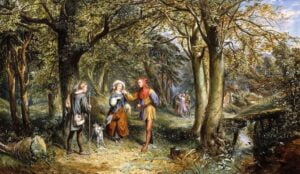
THE FOREST OF ARDEN
By the late 1960s, the ‘back to nature’ movement within alternative culture became prominent, making ‘the pastoral’ a key feature of that culture. Dylan and The Band’s rural retreat in Woodstock was soon to be imitated by many rock bands such as Traffic, Fairport Convention and Led Zeppelin, who were reported to be ‘getting it together in the country’. Such retreats were often positioned as reactions to the excesses and temptations of urban life, with particular reference to excessive drug taking and sexual profligacy. New Morning is one of Dylan’s most ‘autobiographical’ works in that the songs mirror his own retreat from the spotlight of endless tours and promotions. Like the pastoral poets, he imagines himself in a dreamlike ‘state of nature’ which is linked to a kind of spiritual reawakening and a deep enjoyment of simple natural pleasures. His ‘songs of experience’ behind him, he presents his own ‘songs of innocence’. But there is always a hint that the ‘songs of experience’ will one day return. Despite the sheer happiness that is conveyed in many of these short melodic pieces, there is a sense that the singer may soon wake up from his dream.

Time Passes Slowly illustrates these themes with great clarity. The recording is dominated by the interplay between Dylan’s staccato piano runs and snatches of lyrical guitar. The ‘jumpy’ and unpredictable piano lends an air of uncertainty to the song which contrasts against the apparently passive tone of the lyrics. Despite the ‘dreamy’ nature of the song Dylan’s vocal expression tends towards the harsh tones of his pre-1967 work, presenting an illuminating disparity between what is being described and the manner the description is presented. The song begins by instantly placing us within the Arcadian reverie: …Time passes slowly up here in the mountains/ We sit beside bridges and walk beside fountains/ Catch the wild fishes that float through the stream/ Time passes slowly when you’re lost in a dream… Dylan has been quoted as saying that his ambition in writing his songs is to ‘stop time’. Here time has not so much stopped as slowed down, like a silent film being projected at the wrong speed. As in Blake’s Songs of Innocence the imagery is clear, direct and generalised: mountains, bridges, streams, fishes… The fishes are not swimming but ‘floating’; an image of effortlessness, of nature carrying along the narrator – like those fishes – by the currents. But already it is clear that this is all a dream in which the narrator is ‘lost’.

The next line begins…Once I had a sweetheart that was fine and good looking… which combines the name of a traditional English folk song (recorded by Pentangle on their 1969 album Basket of Light) with a nod to Hank Williams’ country classic Hey Good Lookin’. Dylan paints a cosy little picture: …We sat in the kitchen while her mama was cookin’… which uses Williams’ jokey lookin’/cookin’ rhyme. The feeling of dreaminess is never far away. The lovers are depicted, in the style of a typical romantic song, as staring up at the stars in wonder before we hear that …time passes slowly when you’re searchin’ for love… In the bridge section, which follows, Dylan repeats ...Ain’t no reason… four times, indicating that the narrator does not need to go …in a wagon to town…, to the fair… or indeed …anywhere… The narrator clearly wants to stay within his idyllic dream world. Any untoward movements will apparently break the spell.

By the final verse, there is a sense that the narrator and his lover are struggling to maintain their apparent state of perfect happiness: …Time passes slowly up here in the daylight/ We stare straight ahead and try hard to stay right… Time may be passing slowly, but it is obvious that the darkness of night will eventually come. Dylan then presents us with one final resonant image: …Like the red rose of summer that blooms in the day/ Time passes slowly and fades away… There are faint echoes here of Blake’s Sick Rose, which symbolises human corruption and of Shakespeare’s pastoral tour-de-force Sonnet 18 which famously begins …Shall I compare thee to a summer’s day… Just as Shakespeare suggests that the idealised beauty portrayed in his poem will fade in time, when …Rough winds do shake the darling buds of May… so Dylan suggests that the dreamlike illusion of ideal love in ‘slow motion’ will also disappear, just as the freshly picked rose will soon wither and die.

AL KOOPER
The beautifully enigmatic Sign on the Window is perhaps the most fully realised expression of the dilemma Dylan found himself at the end of the 1960s. It conveys a mixture of sadness, elation and philosophical resignation which is virtually unique in popular song. It is also dominated by Dylan’s distinctive piano, which sometimes carries the track alone, with a few interjections of bass and drums and some restrained backing vocals from the female singers. Midway through the song Al Kooper’s organ is featured in a duet with the piano, rather like Richard Manuel and Garth Hudson in The Band. The song is a meditation on the benefits of a pastoral retreat and is a tentative embrace of the kind of conventional values that Dylan’s work had once eschewed. As in Time Passes Slowly, the way the music rises and falls in tone mirrors the narrator’s scattered thoughts. Here the sense of uncertainty is, however, more pronounced. The verses seem somewhat disconnected, as if we are following the narrator’s random thought patterns. It is not clear whether he is a participant in events or just an observer. Dylan’s vocals are sweeter and more restrained than on Time Passes Slowly. Again the song has three short verses and a bridge. The final line of each verse is repeated. Each verse seems self contained. It is as if we are being given a privileged glimpse into the narrator’s mind as he speculates on what his life should be like. As with the earlier song, the listener is left to ‘fill in the gaps’ between apparently random statements. But the impassioned vocals and striking piano playing give the impression that the narrator himself is wrestling with issues that are quietly tormenting him, while still being ‘lost in a dream’.

The first verse presents us with a series of ‘signs’ which can be interpreted in many ways: …Sign on the window says ‘Lonely’… takes us into Roy Orbison territory. We may expect this to be a song of self-pity. But this is followed by the rather harsh …Sign on the door says ‘No Company Allowed’ … Now we get the impression that the narrator’s isolation is quite deliberate. Then there is a hint of a personal drama: …Sign on the street says ‘You Don’t Own Me’… suggesting that the isolation is a reaction to an over-possessive lover. Finally …Sign on the street says ‘Three’s a Crowd’… may suggest that the protagonist has been involved in some kind of stressful ménage-a-trois. Perhaps he has a partner behind that imposing door. Or perhaps, as the next verse infers, his lover has left with a different partner. Here and in succeeding verses the repeated last line appears to represent the narrator attempting to reassure himself that he really believes in his protestations.
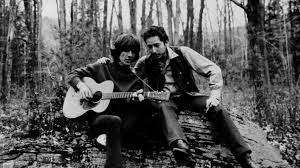
There is more repetition in the second verse, with the use of the rather awkward phrase …Her and her boyfriend… who at first have departed for California and then have …done changed their tune… This faltering, ungrammatical line hints at a bitterness in the narrator. It could be that he feels cheated or betrayed but is trying hard to put a brave face on everything. The details of what has happened will never be revealed, as the verse spirals into the extraordinary. Now the narrator, who is clearly emotionally distraught, appears to be confiding in us: …My best friend said “Now didn’t I warn ya”… which is followed by an impassioned delivery of the rather wonderfully ambiguous repeated line …Brighton girls are like the moon… This could mean that such girls ‘wax and wane’ in their emotions, so that they are distinctly unreliable. Or it might indicate that such females are ‘lights in the darkness’ of his life. ‘Brighton’ could refer to the sizeable resort on England’s south coast or (more likely) a small city in Michigan which – like Dylan’s home town of Hibbing – is near the Great Lakes.

The bridge section is another impressionistic sketch, taking us into what we may presume is the present moment. The narrator does not make the events being depicted in the song any clearer, merely making observations on the weather: …Looks like nothing but rain/ Sure gonna be wet tonight on Main Street/ Hope that it don’t sleet… He appears to be abandoning himself to the vicissitudes of the elements, conjuring up a picture of a man standing in the middle of a street, allowing the ‘hard rain’ to soak him thoroughly. The reference to ‘Main Street’ appears to indicate that we are in a small American town, probably somewhere in the Midwest. Dylan’s voice sounds a little strained here, conveying the insecurity and uncertainty that haunts his narrator.

A CABIN IN UTAH
The final verse is one of the most emotive and challenging in Dylan’s entire oeuvre, despite being constructed in simple language. So far he has presented a picture of a narrator who is beset by turbulent dreams and who may have been abandoned by a lover. Now, standing in the rain in this ‘one horse town’, he dreams of the ultimate escape: …Build me a cabin in Utah/ Marry me a wife, catch rainbow trout… This is very much in tune with the pastoral flavour of the other songs. But the final lines are nothing less than heartbreaking, as he expresses his desire for a ‘normal life’: …Have a bunch of kids who call me ‘pa’/ That must be what it’s all about… Again the final line is repeated. The ambiguity now becomes even richer. Can we really believe that such a simple life is all that Bob Dylan desires? He is living in retreat from the rat race of commercial music making, staying away from the drugs and the groupies and the all night parties, writing apparently simple, straightforward songs in celebration of his new life. At the time he really did have ‘a bunch of kids who called him pa’. But the final repeated lines are almost posed as questions. He may be happy in his rural retreat but is this really ’what it’s all about’?
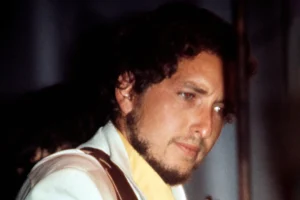
Neither Time Passes Slowly nor Sign on the Window have ever been performed live by Dylan. They are both very much products of a particular time and place in his musical history. The earlier recordings of the songs experiment with musical form, with guitar based versions eventually being replaced by takes that are dominated by Dylan’s piano, which can be said to be the album’s ‘alternative voice’. Al Kooper’s string arrangement of Sign on the Window is quite evocative in conveying the pathos in the song. Judy Collins’ version of Time Passes Slowly – which is enhanced by a tasteful string arrangement – communicates the piece’s dreamlike quality successfully, with Collins’ ethereal vocals conveying the twinges of melancholy in the song effectively. Melanie Safka does not have Collins’ purity of expression, but her more nuanced vocal style, which always hints at an ironic reading of what she is singing, is a perfect fit with Sign on the Window’s mixture of conflicting feelings.
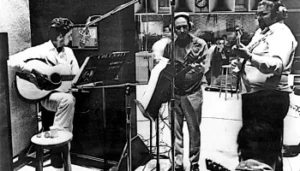
Went to See the Gypsy is another highly ambiguous song whose narrator gives us a certain amount of information and lets us imagine the rest of the action. Like Time Passes Slowly and Sign on the Window it is impressionistic piece with a dreamlike tone which again follows the typical ‘pop format’ of three verses and a bridge. The album version is dominated by Dylan’s piano, with Al Kooper providing washes of organ. Several earlier takes appear on Another Self Portrait and 1970. On the ‘New Morning outtake’ he takes the vocal slowly and sonorously. The ‘demo’ version contains slightly different lyrics. Rather than being led by piano, it features two ‘duelling acoustic guitars’ played by Dylan and David Bromberg and ends with a haunting guitar solo by Bromberg.

The song has long been recognised as an account of a real or (most probably) imagined meeting with Elvis Presley. Dylan once stated in an interview that he had never met ‘the King’, preferring to remember him as the magically iconic performer of the late 1950s who had inspired him to take up music, rather than the ‘neutered’ figure who had spent most of the 1960s appearing in increasingly shoddy and forgettable Hollywood movies. The personification of Elvis as a ‘gypsy’ is interesting if ambiguous. There had at one time been rumours that he did indeed have Romany blood, although these are highly unsubstantiated. It is more likely that Dylan identified some kind of untamed ‘gypsy spirit’ in Presley’s wildly sensual performances. During the New Morning sessions Dylan recorded covers of two Elvis songs, Can’t Help Falling in Love and A Fool Such As I, both of which appeared on the Dylan album in 1973.

The song gives very few details of the supposed encounter. In the first verse Dylan sings …Went to see the Gypsy/ Staying in a big hotel/ He smiled when he saw me coming/ And he said “Well, well, well”… We are not told where the hotel is, but a clue given later in the song strongly suggests that it is in Las Vegas, where Presley was currently booked for his residency at the International Hotel. Presley was also known to add …Well… to the beginning of many of his songs including That’s Alright Mama, Lawdy Miss Clawdy and All Shook Up. This distinctive trick allowed him to take a preliminary breath before launching into his mesmeric rhythmic vocals. But if we think we are about to witness some kind of revelatory conversation between the narrator and ‘the Gypsy’, we will be sorely disappointed. In fact, conversation is made difficult by the fact that …The room was dark and crowded/ The lights were low and dim… Elvis regularly entertained large groups of people after his shows in his extensive suite at the top of the hotel. So the two figures are not alone. But they seem to have little to say to each other: …”How are you?” He said to me. “I said it back to him”. It seems that both Elvis and Dylan are too embarrassed or overwhelmed to speak, especially as they are surrounded by Presley’s acolytes. The dim lighting sets the scene cinematically for this very limited exchange, symbolising the lack of rapport between the two musicians. When the two stars meet they have nothing to say to each other. The song can thus be taken as both a meditation on the hollowness of fame and an explanation of Dylan’s current low profile.

Having built us up for the encounter, we then take an unexpected sideways turn. The narrator leaves the party to go down to the lobby to …make a small call out… This again suggests that he may be rather bored or unimpressed by events upstairs and has made an excuse to exit the scene. Making a ‘small call out’ seems hardly appropriate when engaged in a meeting with the world’s most famous musician. The narrator then encounters a ‘pretty dancing girl’ (who presumably is employed as ‘eye candy’ in one of the Vegas hotels) who implores him to return to the party immediately: …Go on back to see the Gypsy… she shouts …He can move you from your rear/ Drive you from your fear, bring you through the mirror/ He did it in Las Vegas/ And he can do it here… Her description of ‘the Gypsy’ is an eloquent description of the transformative effect Elvis could have on people, ‘bringing them through the mirror’ so they could see themselves in a different way.
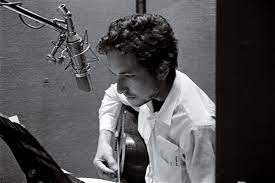
The narrator experiences a movingly reflective moment in the song’s bridge: …Outside the lights were shinin’ on a river of tears/ I watched them from the distance/ With the music in my ears… He has found the meeting to be a very disappointing experience. After all the anticipation, the encounter has left him tearful and hoping to make a quick exit. Finally he follows the girl’s advice. He returns to find that …the Gypsy had gone… Also …That pretty dancing girl, she could not be found… We do not know how long he had spent in the lobby of the hotel but we may imagine that ‘making a small call out’ and taking to the girl must have only taken a few minutes. Dylan sets up a mystery here but provides us with no direct answers. The song then concludes in a highly unexpected way as he sings …So I watched the sun come rising/ From that little Minnesota town… Maybe the narrator has been dreaming the entire scenario. In fact the whole song may depict a teenage Dylan (who indeed grew up in the ‘little Minnesota town’ of Hibbing) imagining a meeting with his hero in which he is too embarrassed or star struck to speak.

Day of the Locusts is one of the few Dylan songs which can be said to be directly autobiographical, as it recounts his experience of – and largely negative reaction to – the award of an honorary degree by Princeton University on June 9th 1970. The account is rather comically exaggerated but is certainly based on the real event. This was the first time that Dylan had received an award from the academic world, or indeed any recognition from ‘the establishment’. He attended the ceremony with his wife Sara and David Crosby, who had apparently ‘laid some killer weed’ on them, leaving Bob in a state of considerable paranoia. Initially he baulked against having to don a cap and gown for the presentation but later acceded. He was also rather ‘freaked out’ by being referred to by one of the speakers as a spokesman for his generation – a label he was steadfastly trying to escape from at the time. The ceremony really was blighted by an invasion of locusts. It was held at an unfortunate time as these crowds of insects only appeared every seventeen years.

The song is given a full band treatment with Dylan leading on piano, Buzzy Feiten on guitar, Al Kooper on organ, Harvey Brooks on bass and Russ Kunkel on drums. It features four verses with four full choruses of …And the locusts sang off in the distance/ And the locusts sang such a sweet melody/ The locusts sang in a high whining trill/ The locusts sang, they were singin’ for me… with a few variations. This ‘plague of locusts’ has obvious Biblical connotations, although Dylan does not milk this in any way. The title of the song also refers to Nathaniel West’s satirical novel Day of the Locust (1939) in which a Hollywood film premiere turns into a violent riot. Dylan mocks his own nervousness and paranoia at the ceremony, with the last line of the chorus inferring that the infernal buzzing of the locusts is reflecting the chaos in his own mind as he suffers through the ceremony.
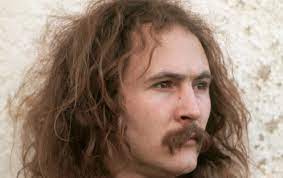
DAVID CROSBY
We kick off with some comical description: …The benches were stained with tears and perspiration/ The birdies were flying from tree to tree… It will soon be clear that the ‘tears and perspiration’ are those of the narrator himself. The use of the rather childish term ‘birdies’ appears to reflect the narrator’s inebriated state of mind. He tells us that there was …little to say, there was no conversation… as he steps up to accept the award. The opening lines of the second verse again present the scene from his paranoid point of view: …I glanced into the room where the judges were talkin’/ Darkness was everywhere, it smelled like a tomb… In his mind, the gowned academics resemble ‘judges’. Since dropping out of college in 1961 Dylan had had a strained relationship with academia – expressed most eloquently in the bitterly sarcastic Ballad of a Thin Man. At the same time he clearly considered himself a serious poet. Now in his fantasy he feels he is being ‘judged’ and seems scared of being trapped in the kind of academic mind set he had always railed against. He tells us that he feels like running away there and then but suddenly he sees …light in the room…
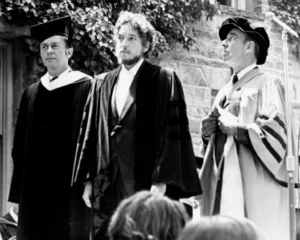
DYLAN AT PRINCETON DEGREE AWARD, 1970
Despite this sudden moment of calm, it is obvious that he will only be happy once the ceremony is over. His mind is barely focused on what is happening to him. He hears trucks unloading in the distance and (using a rather obvious pun) states that …the weather was hot, nearly ninety degrees… Then, in a reference to the absolutely ‘loaded’ Crosby, he delivers the song’s funniest lines: …The man standing next to me, his head was exploding/ I was praying the pieces wouldn’t fall on me… Finally he discards his gown, grabs his diploma and his ‘sweetheart’ and makes a swift exit …straight for the hills, the Black Hills of Dakota… With a final sigh of relief he declares …Sure was glad to get out of there alive!… In reality the Black Hills are almost two thousand miles from Princeton University, which is in New Jersey. But Day of the Locusts is, of course, not a documentary but a comically stoned reverie. It is a little ironic that Dylan – with his newly shorn hair and modest ‘regular guy’ self presentation of his ‘rural retreat’ years – now presents his audience with such an obvious ‘stoner’s song’.



Leave a Reply